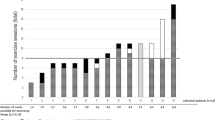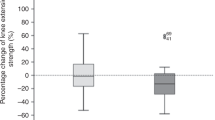Abstract
Patients undergoing allo-HCT often experience a substantial loss in physical performance. We have recently published the general effectiveness of an exercise intervention in 105 allo-HCT patients on physical performance and psychosocial well-being. However, predictor variables for differentiated treatment response remained unclear. To determine the impact of basic physical performance on treatment response, we assessed muscle strength and endurance performance at four assessment points before and after allo-HCT. The exercise group started training 2 weeks before admission and ended 6–8 weeks after discharge. Comparing initially fit with unfit classified patients, the fit patients lost 31% of the strength of the knee-extensors, whereas the unfit patients lost only 1% (P<0.05). For endurance capacity, fit patients lost 4% of their walking capability, whereas unfit patients gained 13% (P<0.05). The individual percent change was statistically different at the 0.05 level in all measures of physical performance. Individual training response in allo-HCT patients strongly depends on the initial physical performance level. Unfit patients can be trained safely and may benefit more from this exercise intervention than fit patients. This result is of major clinical relevance and should encourage hematologists to promote exercise even more in impaired/unfit allo-HCT patients.
This is a preview of subscription content, access via your institution
Access options
Subscribe to this journal
Receive 12 print issues and online access
$259.00 per year
only $21.58 per issue
Buy this article
- Purchase on Springer Link
- Instant access to full article PDF
Prices may be subject to local taxes which are calculated during checkout



Similar content being viewed by others
References
Copelan EA . Hematopoietic stem-cell transplantation. N Engl J Med 2006; 354: 1813–1826.
Morishita S, Kaida K, Ikegame K, Yoshihara S, Taniguchi K, Okada M et al. Impaired physiological function and health-related QOL in patients before hematopoietic stem-cell transplantation. Support Care Cancer 2012; 20: 821–829.
White AC, Terrin N, Miller KB, Ryan HF . Impaired respiratory and skeletal muscle strength in patients prior to hematopoietic stem-cell transplantation. Chest 2005; 128: 145–152.
Mosher CE, Redd WH, Rini CM, Burkhalter JE, DuHamel KN . Physical, psychological, and social sequelae following hematopoietic stem cell transplantation: a review of the literature. Psychooncology 2009; 18: 113–127.
Mitchell SA, Leidy NK, Mooney KH, Dudley WN, Beck SL, LaStayo PC et al. Determinants of functional performance in long-term survivors of allogeneic hematopoietic stem cell transplantation with chronic graft-versus-host disease (cGVHD). Bone Marrow Transplant 2010; 45: 762–769.
Schmitz KH, Courneya KS, Matthews C, Demark-Wahnefried W, Galvao DA, Pinto BM et al. American College of Sports Medicine roundtable on exercise guidelines for cancer survivors. Med Sci Sports Exerc 2010; 42: 1409–1426.
Wiskemann J, Huber G . Physical exercise as adjuvant therapy for patients undergoing hematopoietic stem cell transplantation. Bone Marrow Transplant 2008; 41: 321–329.
Coleman EA, Coon SK, Kennedy RL, Lockhart KD, Stewart CB, Anaissie EJ et al. Effects of exercise in combination with epoetin alfa during high-dose chemotherapy and autologous peripheral blood stem cell transplantation for multiple myeloma. Oncol Nurs Forum 2008; 35: E53–E61.
Shelton ML, Lee JQ, Morris GS, Massey PR, Kendall DG, Munsell MF et al. A randomized control trial of a supervised versus a self-directed exercise program for allogeneic stem cell transplant patients. Psychooncology 2008; 18: 353–359.
Jarden M, Baadsgaard MT, Hovgaard DJ, Boesen E, Adamsen L . A randomized trial on the effect of a multimodal intervention on physical capacity, functional performance and quality of life in adult patients undergoing allogeneic SCT. Bone Marrow Transplant 2009; 43: 725–737.
Hacker ED, Larson J, Kujath A, Peace D, Rondelli D, Gaston L . Strength training following hematopoietic stem cell transplantation. Cancer Nurs 2011; 34: 238–249.
Knols RH, de Bruin ED, Shirato K, Uebelhart D, Aaronson NK . Physical activity interventions to improve daily walking activity in cancer survivors. BMC Cancer 2010; 10: 406.
Wiskemann J, Dreger P, Schwerdtfeger R, Bondong A, Huber G, Kleindienst N et al. Effects of a partly self-administered exercise program before, during, and after allogeneic stem cell transplantation. Blood 2011; 117: 2604–2613.
Skinner JS, Jaskolski A, Jaskolska A, Krasnoff J, Gagnon J, Leon AS et al. Age, sex, race, initial fitness, and response to training: the HERITAGE Family Study. J Appl Physiol 2001; 90: 1770–1776.
Gruber W, Orenstein DM, Braumann KM . Do responses to exercise training in cystic fibrosis depend on initial fitness level? Eur Respir J 2011; 38: 1336–1342.
Knols RH, Aufdemkampe G, de Bruin ED, Uebelhart D, Aaronson NK . Hand-held dynamometry in patients with haematological malignancies: measurement error in the clinical assessment of knee extension strength. BMC Musculoskelet Disord 2009; 10: 31.
Mello M, Tanaka C, Dulley FL . Effects of an exercise program on muscle performance in patients undergoing allogeneic bone marrow transplantation. Bone Marrow Transplant 2003; 32: 723–728.
Bohannon RW . Reference values for extremity muscle strength obtained by hand-held dynamometry from adults aged 20–79 years. Arch Phys Med Rehabil 1997; 78: 26–32.
Enright PL . The six-minute walk test. Respir Care 2003; 48: 783–785.
Crapo R, Casaburi R, Coaties A, Enright P, MacIntyre N, McKay P et al. ATS statement: guidelines for the six-minute walk test. Am J Respir Crit Care Med 2002; 166: 111–117.
Smets EM, Garssen B, Bonke B, de Haes JC . The Multidimensional Fatigue Inventory (MFI) psychometric qualities of an instrument to assess fatigue. J Psychosom Res 1995; 39: 315–325.
Aaronson NK, Ahmedzai S, Bergman B, Bullinger M, Cull A, Duez NJ et al. The European Organization for Research and Treatment of Cancer QLQ-C30: a quality-of-life instrument for use in international clinical trials in oncology. J Natl Cancer Inst 1993; 85: 365–376.
Holland JC, Andersen B, Breitbart WS, Dabrowski M, Dudley MM, Fleishman S et al. Distress management. J Natl Compr Canc Netw 2007; 5: 66–98.
Enright PL, Sherrill DL . Reference equations for the six-minute walk in healthy adults. Am J Respir Crit Care Med 1998; 158 (5 Pt 1): 1384–1387.
Baumann FT, Zopf EM, Nykamp E, Kraut L, Schule K, Elter T et al. Physical activity for patients undergoing an allogeneic hematopoietic stem cell transplantation: benefits of a moderate exercise intervention. Eur J Haematol 2011; 87: 148–156.
DeFor TE, Burns LJ, Gold EM, Weisdorf DJ . A randomized trial of the effect of a walking regimen on the functional status of 100 adult allogeneic donor hematopoietic cell transplant patients. Biol Blood Marrow Transplant 2007; 13: 948–955.
Vallance JK, Courneya KS, Plotnikoff RC, Yasui Y, Mackey JR . Randomized controlled trial of the effects of print materials and step pedometers on physical activity and quality of life in breast cancer survivors. J Clin Oncol 2007; 25: 2352–2359.
Majhail NS, Rizzo JD, Lee SJ, Aljurf M, Atsuta Y, Bonfim C et al. Recommended screening and preventive practices for long-term survivors after hematopoietic cell transplantation. Bone Marrow Transplant 2012; 47: 337–341.
De Lisio M, Baker JM, Parise G . Exercise promotes bone marrow cell survival and recipient reconstitution post-bone marrow transplantation, which is associated with increased survival. Exp Hematol 2013; 41: 143–154.
Weiss BM, Vogl DT, Berger NA, Stadtmauer EA, Lazarus HM . Trimming the fat: obesity and hematopoietic cell transplantation. Bone Marrow Transplant 2013; 48: 1152–1160.
Urbain P, Birlinger J, Lambert C, Finke J, Bertz H, Biesalski HK . Longitudinal follow-up of nutritional status and its influencing factors in adults undergoing allogeneic hematopoietic cell transplantation. Bone Marrow Transplant 2013; 48: 446–451.
Acknowledgements
The study was funded by the German Jose Carreras Leukemia Foundation (2006–2008; project no. R05/33p).
Author information
Authors and Affiliations
Corresponding author
Ethics declarations
Competing interests
The authors declare no conflict of interest.
Rights and permissions
About this article
Cite this article
Wiskemann, J., Kuehl, R., Dreger, P. et al. Efficacy of exercise training in SCT patients-who benefits most?. Bone Marrow Transplant 49, 443–448 (2014). https://doi.org/10.1038/bmt.2013.194
Received:
Revised:
Accepted:
Published:
Issue Date:
DOI: https://doi.org/10.1038/bmt.2013.194
Keywords
This article is cited by
-
Preventing the adverse cardiovascular consequences of allogeneic stem cell transplantation with a multi-faceted exercise intervention: the ALLO-Active trial protocol
BMC Cancer (2022)
-
Feasibility of early-commencing group-based exercise in allogeneic bone marrow transplantation: the BOOST study
Bone Marrow Transplantation (2021)
-
Rehabilitation bei Patienten nach Stammzelltransplantationen
InFo Hämatologie + Onkologie (2020)
-
Safety and feasibility of electrical muscle stimulation in patients undergoing autologous and allogeneic stem cell transplantation or intensive chemotherapy
Supportive Care in Cancer (2019)
-
A hospital and home-based exercise program to address functional decline in people following allogeneic stem cell transplantation
Supportive Care in Cancer (2018)



